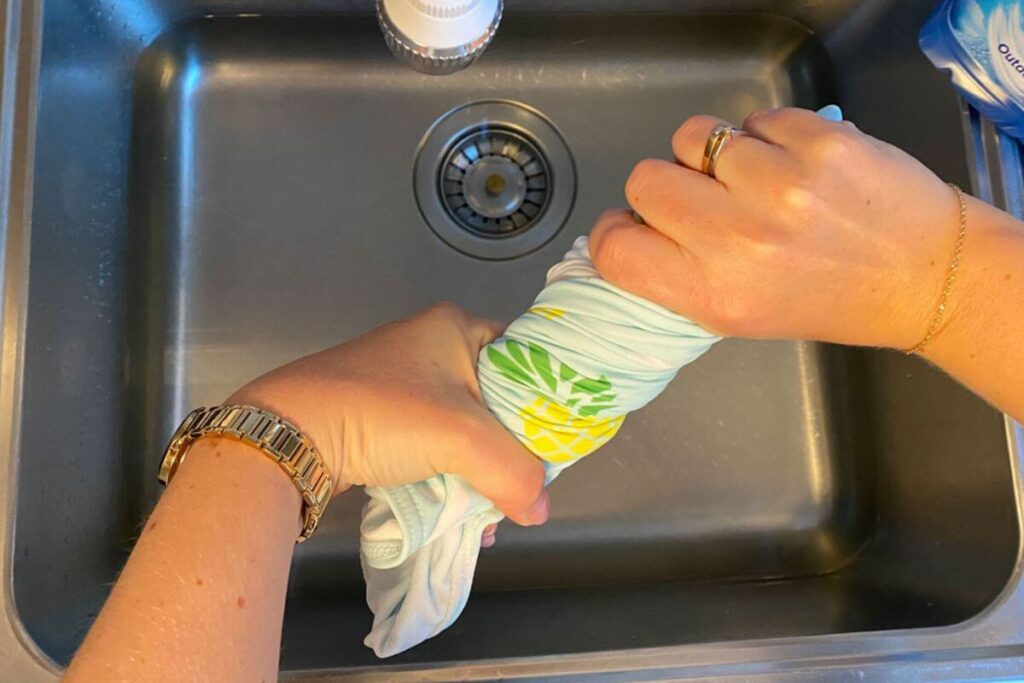Discovering mold on your favorite bathing suit can be disheartening, but fear not! With the right approach, you can effectively eliminate mold and restore your swimwear to its former glory. In this comprehensive guide, we’ll explore various methods to safely and efficiently get rid of mold from your cherished bathing suit.
I. Understanding Mold Growth on Bathing Suits
A. Causes of Mold Growth
1. Dampness:
Mold thrives in damp environments, making bathing suits susceptible if not thoroughly dried after use.
2. Improper Storage:
Storing damp swimwear in a confined space, like a beach bag, provides an ideal breeding ground for mold.
3. Prolonged Moisture Exposure:
Leaving a wet bathing suit in a locker or bag for an extended period encourages mold development.
II. Preventive Measures for Mold Growth
A. Thorough Drying After Use
- After swimming, promptly rinse your bathing suit with cold water and allow it to air-dry completely before storage.

B. Proper Storage
- Store your bathing suit in a well-ventilated area. Avoid sealing it in plastic bags or containers when damp.
C. Rotate Between Swimsuits
- If possible, rotate between multiple swimsuits to give each one sufficient time to dry and prevent mold buildup.
III. Methods to Remove Mold from Bathing Suits
A. Vinegar Soak
i. Ingredients:
- White vinegar
- Coldwater
ii. Procedure:
- Fill a basin or sink with cold water.
- Add one cup of white vinegar.
- Submerge the mold-affected area and let it soak for 30 minutes.
- Gently scrub the fabric with a soft brush.
- Rinse thoroughly with cold water.
B. Baking Soda Paste
i. Ingredients:
- Baking soda
- Coldwater
ii. Procedure:
- Create a paste by mixing baking soda with enough cold water.
- Apply the paste to the mold-affected areas.
- Gently scrub using a soft brush or your fingers.
- Allow it to sit for 15-20 minutes.
- Rinse the bathing suit thoroughly with cold water.
C. Lemon Juice and Sunlight
i. Ingredients:
- Fresh lemon juice
- Sunlight
ii. Procedure:
- Apply fresh lemon juice to the mold-affected areas.
- Place the bathing suit in direct sunlight for 1-2 hours.
- Lemon juice, combined with sunlight, acts as a natural mold remover.
- Rinse the bathing suit with cold water.
D. Mild Detergent Wash
i. Ingredients:
- Mild detergent
- Coldwater
ii. Procedure:
- Fill a basin with cold water.
- Add a small amount of mild detergent.
- Gently agitate the water to create suds.
- Submerge the bathing suit and gently scrub.
- Rinse thoroughly with cold water.
IV. Post-Treatment Care
A. Air Dry Only
- After mold removal, avoid using a dryer. Air dry your bathing suit to prevent further damage to the fabric.
B. Inspect for Residual Mold
- After drying, inspect the bathing suit for any remaining mold. If spots persist, consider repeating the treatment.
C. Store in a Ventilated Space
- Store your bathing suit in a well-ventilated area to discourage mold regrowth.
V. Conclusion: A Mold-Free Return to the Waves
In conclusion, combating mold on your bathing suit requires a combination of preventive measures and targeted treatments. By understanding the causes of mold growth and implementing the suggested methods, you can bid farewell to mold and welcome your swimwear back into your beach essentials.
May your bathing suit remain a mold-free companion, ready for countless adventures under the sun and in the waves.
VI. Maintaining Mold-Free Swimwear
A. Post-Swim Rinse Routine
- Incorporate a post-swim rinse routine into your beach or pool day. Rinse your bathing suit with cold water immediately after use to remove salt, chlorine, and other potential mold contributors.
B. Anti-Microbial Sprays
- Consider using anti-microbial sprays designed for swimwear. These sprays can help prevent mold growth by inhibiting the development of bacteria and fungi.
VII. Dealing with Lingering Mold Odor
A. Baking Soda Deodorizing Soak
i. Ingredients:
- Baking soda
- Coldwater
ii. Procedure:
- Mix a cup of baking soda with cold water to create a solution.
- Soak the bathing suit in this solution for 1-2 hours.
- Rinse thoroughly with cold water.
- Air dry the bathing suit.
B. Activated Charcoal Sachets
- Place activated charcoal sachets in the vicinity of your stored bathing suits. Activated charcoal absorbs moisture and helps control mold odors.
VIII. Handling Mold on Different Fabric Types
A. Lycra/Spandex Blend Care
- If your bathing suit contains Lycra or Spandex, be extra cautious with mold prevention. These materials can be more sensitive, requiring diligent drying and proper storage.
B. Delicate Fabric Considerations
- Delicate fabrics may require extra care during mold removal. Gentle treatments and handwashing are essential to avoid damaging the delicate fibers.
IX. Professional Cleaning (For Severe Cases)
A. Consulting with Experts
- In severe cases where mold persists, consider consulting with professionals who specialize in fabric restoration. They may have advanced techniques to salvage your cherished swimwear.
X. Conclusion: A Mold-Free Splash Every Time
In conclusion, maintaining a mold-free bathing suit involves a proactive approach, timely treatments, and an understanding of the unique characteristics of different fabrics. By incorporating preventive measures and swift remedies, you can enjoy your swimwear season after season without the unwelcome presence of mold.
May your bathing suits continue to be a symbol of fun, sun, and carefree moments, devoid of any mold-related concerns. Dive back into the waves with confidence, knowing that your swimwear is primed for every beach adventure.
Frequently Asked Questions (FAQs) about Removing Mold from Bathing Suits
How can I prevent mold from growing on my bathing suit?
Thoroughly dry your bathing suit after each use before storing it in a well-ventilated area. Rotate between multiple swimsuits to allow each one sufficient drying time.
Can I use bleach to remove mold from my bathing suit?
It’s not recommended to use bleach, as it can damage the fabric and affect the color. Opt for gentler remedies like vinegar, baking soda, or lemon juice.
How long should I soak my bathing suit in vinegar to remove mold?
Soak your bathing suit in a vinegar solution for approximately 30 minutes. Gently scrub the mold-affected areas and rinse thoroughly with cold water.
Is it safe to use baking soda on all types of fabrics?
Baking soda is generally safe for most fabrics, but perform a spot test in an inconspicuous area before using it on the entire bathing suit. It’s effective for removing mold and deodorizing.
Can I remove mold from a bathing suit by washing it in a washing machine?
It’s recommended to hand wash your bathing suit with mild detergent. Machine washing can be harsh on delicate fabrics and may contribute to mold growth.
How do I get rid of the moldy smell from my bathing suit?
Try a baking soda deodorizing soak by mixing baking soda with cold water. Soak the bathing suit for 1-2 hours, rinse thoroughly, and air dry. Activated charcoal sachets can also help control lingering mold odors.
What if mold persists after trying these methods?
If mold persists, consult professionals who specialize in fabric restoration. They may have advanced techniques to salvage your bathing suit.
Can I use anti-microbial sprays on all types of bathing suits?
Anti-microbial sprays designed for swimwear are generally safe for various fabric types. Follow the product instructions to ensure proper application.
How often should I perform mold prevention routines?
Incorporate post-swim rinses and preventive routines after every use. Consider anti-microbial sprays and deodorizing treatments periodically, especially if your bathing suit is frequently used.
Is mold removal safe for delicate fabrics?
Mold removal should be approached with caution for delicate fabrics. Use gentle treatments, handwashing, and avoid excessive scrubbing to prevent damage to delicate fibers.



